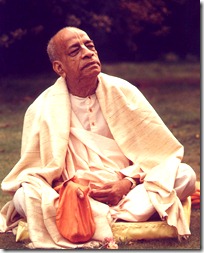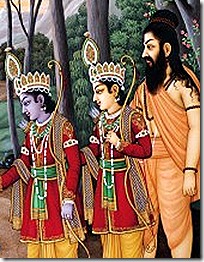 “Of all that is material and all that is spiritual in this world, know for certain that I am both its origin and dissolution.” (Lord Krishna, Bhagavad-gita, 7.6)
“Of all that is material and all that is spiritual in this world, know for certain that I am both its origin and dissolution.” (Lord Krishna, Bhagavad-gita, 7.6)“I’m happy with my life and you’re happy with yours, so what’s the big deal then? Why do I need to worship God if I’m already satisfied from my work? I don’t feel that the days are repetitive, nor is my journey lacking exciting adventures. I love meeting new people, learning from their tendencies and acting out on my desires for happiness. This outlook has worked for me thus far, so why should I change anything? Yes, I understand that death will approach, but shouldn’t that inspire me to make the most out of my life right now? Everyone is pleased by doing what they like to do, so what if religion just isn’t for me?” 
The spiritualist inclined to worship the Supreme Lord in His personal form through regularly
chanting His names, “
Hare Krishna Hare Krishna, Krishna Krishna, Hare Hare, Hare Rama Hare Rama, Rama Rama, Hare Hare”, visiting temples, worshiping the
deity, reading authorized books about Him, spending hours taxing the brain to understand the highest truths of life and condition oneself for better appreciating the Supreme Lord’s association, and a host of other activities naturally wants to share their joy, the experience gathered from their efforts and their tasting of the fruit of existence, with others.
It’s easier to convince someone of a high philosophy when they are struggling, mentally disturbed over the unfair hand that life has dealt them. The most obvious time to turn to spiritual life is after the death of a friend or family member. That person, whose association we cherished, is no longer with us, taken away from the mind’s vision. No longer will we be able to share laughter with them, tell them how much we care about them, or hear their brilliant words of wisdom. “Why do they have to leave? Why does their absence hurt so much? When will my day come? If we all have to die, why do we have to live?”
The Bhagavad-gita, the Song of God and most concise and complete treatise on spirituality, explains these issues in the best way that the human being can understand them. Notice that we don’t say that the Bhagavad-gita is a
Hindu scripture or a matter of faith that has to be subscribed to immediately. Some will certainly describe this tiny chapter from the famous
Mahabharata in this way, but the speaker of the Gita, who is also revealed to be the original creator of all energies, the Supreme Lord Himself, does not present the work as a matter of faith. Rather, the backdrop for the teachings is the hesitation of a previously fearless and fully capable warrior. Not wanting to commence fighting against enemies who were deserving of punishment, this warrior was puzzled as to the role he was meant to play, what he was supposed to do, and if the prescribed action would be beneficial to him and the other members gathered on the battlefield that day.
“According to one's existence under the various modes of nature, one evolves a particular kind of faith. The living being is said to be of a particular faith according to the modes he has acquired.” (
Lord Krishna,
Bhagavad-gita, 17.3)

Shri Krishna, the speaker of the Gita, then explained the right course of action in a series of different ways, which were meant to apply to the different faiths that people adopt. Depending on the modes of material nature encasing the spirit soul at the time of birth, the living being adopts a certain kind of faith. Does this mean that the animals also have faith? What about the human beings such as children that don’t know anything? The default condition is ignorance, wherein one doesn’t even know the proper way to get their desired aim. As you steadily ascend the chain of knowledge, not only do the activities become purer, but so do the objectives.
Krishna presented the correct choice to Arjuna through the prism of the different modes of material nature. To begin, it was revealed that the spirit soul is the essence of identity, the force behind action. When we see a person who has just passed away, it’s a little strange to think that they are no longer living. The same body is there, but it is now considered lifeless. If only an injection could be made to give the person life again. That “thing” being injected is the spirit soul, which is the seed of existence. Its presence allows for growth, development and eventual decay. Its exit signals the end of the particular being’s existence, though the essence of identity continues to remain vibrant eternally. Since the soul is eternal, slaying someone else in a battle fought under bona fide religious principles does not bring sin to anyone. A sin is just an act that carries a negative consequence; hence sinful behavior should be avoided. One who knows the soul lives in the mode of goodness, which thus represents the kind of faith they adopt.
“That knowledge by which a different type of living entity is seen to be dwelling in different bodies is knowledge in the mode of passion.” (Lord Krishna, Bg. 18.21)
Those in the mode of passion, which is the default mode for the mature human being, think that actions lead to happiness and sadness, and that the body’s welfare is of paramount importance. In one sense, this is where Arjuna’s mind had temporarily drifted towards, for he was worried about killing his friends and family members fighting for the other side. In addition, he was afraid of the sin that would be incurred for having performed such an act. Krishna rightfully pointed out that even under Arjuna’s thinking fighting ahead would be the correct option. Arjuna was famous for being a courageous fighter. For one who has been previously honored, being dishonored is worse than being killed. Arjuna would be dishonored for fleeing the battlefield. He would forever be known as a coward. The opposing warriors would actually respect him more if he stood up and fought, even if he should fail.
“If, however, you think that the soul is perpetually born and always dies, still you have no reason to lament, O mighty-armed.” (Lord Krishna, Bg. 2.26)

In the mode of ignorance one doesn’t even know how to get the happiness they are looking for. Think of being amazed at a blazing fire and trying to touch it. Nothing good will come from the contact, either in the present or in the future; hence the act is part of ignorance. Oversleeping and excessive
intoxication fall into the mode of ignorance because they further no beneficial end. If one applied the mode of ignorance to Arjuna’s situation, wherein the future benefits wouldn’t be thought about, that the living beings were just a collection of chemicals that dissipated at the time of death, fighting would
still be the correct option. When there is birth, death is guaranteed. If we’re all going to die anyway, why not take the option of fighting? If everything ends with death, what is the use in worrying about the other side and what will happen to them, for they are going to die anyway?
From Krishna’s wonderful presentation we see that no matter what mode of material life a person finds themselves in, the prescriptions presented by those following the transcendental engagement of bhakti-yoga, or
devotional service, are worthwhile. If a person is happy living their material life and jumping from one venture to another, they still can’t produce anything on their own. The circumstances of their birth were determined by other intelligent beings, namely the mother and father. The protection afforded during the dependent childhood years were also out of the hands of the individual. So many factors contribute to the successes that we have, the falling into place of the right pieces. Therefore we should be thankful to at least the immediately identified benefactors.
That gratitude is already expressed to some degree. If this weren’t the case, there would be no such things as award shows and in-depth cover stories in magazines that hail a particular industry tycoon or famous actor. The penchant towards praise, offering service to others, is already there. It is said in the Gita that Krishna is the taste of water. He is the essence of so many things, such as the penances of the ascetics and the original fragrance of the earth. Just by picking up a flower and smelling it, one can think of Krishna. In odd cases where one is deeply mired in ignorance through regular intoxication, if one just thinks of their beloved wine and remembers that Krishna is its taste, some spiritual merits can accumulate.
And what is the harm in showing this appreciation? If you are well situated, what would it hurt you to chant the holy names, to recognize that a higher, more intelligent power makes sure that there is no randomness with the sun, moon and earthly elements? If there were only randomness, we could never predict weather patterns and what time the sun rises and sets. The essential elements in life are bountifully provided by the Supreme Lord. Those things that we need, like water, grains and milk, are in much higher supplies than those things that we don’t need, such as animal flesh, jewelry and industrial products. This proves that the Supreme Lord is the most benevolent, that everyone who is happy owes their pleasant condition to Him. Those who are distressed by the turn of events are also favored by the Supreme Lord, for the lack of material fortune helps to speed along the search for higher truths.
Those in the mode of pure goodness understand that the pleasant conditions in even material life are due to Shri Krishna’s favor. We could say that such opulence is due to the individual’s effort, but we know that some people work very hard and don’t succeed. Many businesses fail, and many people are dealt difficult hands in life, where they are forced to direct their attention to areas that they may not prefer. Therefore we know that human effort alone is not the cause of the results of action.
One area where effort does make a significant impact, however, is in the relationship to the Supreme Lord. His benevolence is diffused everywhere, but unless one makes a conscious effort to appreciate and take advantage of it for the right purposes, the most blissful meeting between the individual soul and the Supreme Soul cannot take place. Just as the results in other areas of life are not fully in our control, by taking to bhakti, turning one’s eyes towards the Supreme Lord in a mood of love, the forthcoming reactions are also out of our hands. Shri Krishna Himself takes full responsibility for the conditions of those who surrender to Him. This is what Arjuna would eventually do, fighting ahead without attachment and without desire for gain. He simply wanted to please Krishna, to remain connected with Him. Krishna took care of the rest.
“O son of Kunti, all that you do, all that you eat, all that you offer and give away, as well as all austerities that you may perform, should be done as an offering unto Me.” (Lord Krishna, Bg. 9.27)

How can we leave everything to Krishna, especially if we are not inclined towards spiritual life? The holy name is Krishna’s most potent incarnation in the modern age. Just sacrifice a little time each day to chant this name, taking it as the most important regulative practice, the one thing that shouldn’t be missed in the daily routine. From connecting with Krishna, one doesn’t even need to explicitly ascend the chain of knowledge. Bhakti-yoga is in pure goodness, so not only are the activities pure, but so is the ultimate objective, that of remaining in yoga, or pure connection with God. What reward can be better than this? Just as each new day brings a renewed vigor to glorify Krishna and remember Him, the future life for the spirit soul maintains the divine connection and enthusiasm for spiritual life. The life as we know it now is simply a demarcation of time, sort of like a splice from a timeline marked off by a start and stop point. The timeline continues regardless of our viewpoint. Whether we splice or not, the soul will continue to exist. In this sense life carries on after the present body perishes. Though the body goes away, that inherent link to Krishna does not for the surrendered soul fully immersed in bhakti.
In all cases, whether impoverished or extremely wealthy, there is always a reason to think of God, worship Him, honor Him and ask Him to remain within the consciousness. Such practices make every situation favorable. The mind can make or break our happiness very quickly, so combine a properly situated mind with the blessings of Krishna and what you’ll get is an endless engagement, one that never fails to provide pleasure.
In Closing:
“Listen to words about God should I why?
Already happily situated am I.
What need for religion when not in distress?
Through my own efforts happiness addressed.”
Worship of God is beneficial regardless,
Whether you’re in pain or constant happiness.
Devotion to Krishna fits every situation,
Know it from Bhagavad-gita’s flawless presentation.
Arjuna, powerful warrior distressed in mind,
From accepting Lord’s words victory to find.
 “When the muni looked at Rama with His brothers, his eyes welled up with tears, his body became thrilled with excitement, and his mind became so enchanted by the beauty.” (Janaki Mangala, 18)
“When the muni looked at Rama with His brothers, his eyes welled up with tears, his body became thrilled with excitement, and his mind became so enchanted by the beauty.” (Janaki Mangala, 18) What are some of the emotions that a beautiful object elicits? Excitement is surely one of them. “Look at what I’m seeing. I can’t take my eyes off of this. I don’t want to ever not be able to see this again.” In modern times a person’s excitement over an image can be seen through their buying of a painting or storing of a photograph on their computer or handheld electronic device. Along with excitement, there could be the enchantment of the mind. In Sanskrit mohana can refer to the ability to enchant someone through attractiveness, and the more enchanting the object is, the greater their beauty. The ability to captivate the mind belongs only to those truly special works of art.
What are some of the emotions that a beautiful object elicits? Excitement is surely one of them. “Look at what I’m seeing. I can’t take my eyes off of this. I don’t want to ever not be able to see this again.” In modern times a person’s excitement over an image can be seen through their buying of a painting or storing of a photograph on their computer or handheld electronic device. Along with excitement, there could be the enchantment of the mind. In Sanskrit mohana can refer to the ability to enchant someone through attractiveness, and the more enchanting the object is, the greater their beauty. The ability to captivate the mind belongs only to those truly special works of art. Another kind of muni is a devoted soul, a high thinker who has wisely chosen in favor of bhakti-yoga, or
Another kind of muni is a devoted soul, a high thinker who has wisely chosen in favor of bhakti-yoga, or The holy name is the embodiment of the supreme person it represents. Through love for the holy name, love for Godhead takes place automatically. Vishvamitra’s high standing in bhakti was shown by the reaction he had upon seeing Rama and His brothers. Tears welled up in his eyes, a thrill of excitement went through his body, and his mind became enchanted by Rama’s beauty. In the Vedas, the god of love, Kama, who is the equivalent of a cupid, is known as Madana. The Supreme Lord is so beautiful that He is known as Madana-mohana, or the enchanter of cupid. God’s spiritual form attracts even the liberated souls, captivating their minds and directing them towards transcendental love.
The holy name is the embodiment of the supreme person it represents. Through love for the holy name, love for Godhead takes place automatically. Vishvamitra’s high standing in bhakti was shown by the reaction he had upon seeing Rama and His brothers. Tears welled up in his eyes, a thrill of excitement went through his body, and his mind became enchanted by Rama’s beauty. In the Vedas, the god of love, Kama, who is the equivalent of a cupid, is known as Madana. The Supreme Lord is so beautiful that He is known as Madana-mohana, or the enchanter of cupid. God’s spiritual form attracts even the liberated souls, captivating their minds and directing them towards transcendental love. The incident of Vishvamitra’s visit shows us what influence Rama has on people who have a pure heart. The aim of religious practice is to remove the distractions and intoxicating influence of material nature so that the sweet vision of the Supreme Lord can be relished. If we watch a movie while distracted in mind, will we enjoy the most important aspects? Can we concentrate on a conversation with our friends if our mind is distracted? Can we study for an important exam if we are intoxicated?
The incident of Vishvamitra’s visit shows us what influence Rama has on people who have a pure heart. The aim of religious practice is to remove the distractions and intoxicating influence of material nature so that the sweet vision of the Supreme Lord can be relished. If we watch a movie while distracted in mind, will we enjoy the most important aspects? Can we concentrate on a conversation with our friends if our mind is distracted? Can we study for an important exam if we are intoxicated? “Of all that is material and all that is spiritual in this world, know for certain that I am both its origin and dissolution.” (Lord Krishna, Bhagavad-gita, 7.6)
“Of all that is material and all that is spiritual in this world, know for certain that I am both its origin and dissolution.” (Lord Krishna, Bhagavad-gita, 7.6) The spiritualist inclined to worship the Supreme Lord in His personal form through regularly
The spiritualist inclined to worship the Supreme Lord in His personal form through regularly  Shri Krishna, the speaker of the Gita, then explained the right course of action in a series of different ways, which were meant to apply to the different faiths that people adopt. Depending on the modes of material nature encasing the spirit soul at the time of birth, the living being adopts a certain kind of faith. Does this mean that the animals also have faith? What about the human beings such as children that don’t know anything? The default condition is ignorance, wherein one doesn’t even know the proper way to get their desired aim. As you steadily ascend the chain of knowledge, not only do the activities become purer, but so do the objectives.
Shri Krishna, the speaker of the Gita, then explained the right course of action in a series of different ways, which were meant to apply to the different faiths that people adopt. Depending on the modes of material nature encasing the spirit soul at the time of birth, the living being adopts a certain kind of faith. Does this mean that the animals also have faith? What about the human beings such as children that don’t know anything? The default condition is ignorance, wherein one doesn’t even know the proper way to get their desired aim. As you steadily ascend the chain of knowledge, not only do the activities become purer, but so do the objectives. In the mode of ignorance one doesn’t even know how to get the happiness they are looking for. Think of being amazed at a blazing fire and trying to touch it. Nothing good will come from the contact, either in the present or in the future; hence the act is part of ignorance. Oversleeping and excessive
In the mode of ignorance one doesn’t even know how to get the happiness they are looking for. Think of being amazed at a blazing fire and trying to touch it. Nothing good will come from the contact, either in the present or in the future; hence the act is part of ignorance. Oversleeping and excessive  How can we leave everything to Krishna, especially if we are not inclined towards spiritual life? The holy name is Krishna’s most potent incarnation in the modern age. Just sacrifice a little time each day to chant this name, taking it as the most important regulative practice, the one thing that shouldn’t be missed in the daily routine. From connecting with Krishna, one doesn’t even need to explicitly ascend the chain of knowledge. Bhakti-yoga is in pure goodness, so not only are the activities pure, but so is the ultimate objective, that of remaining in yoga, or pure connection with God. What reward can be better than this? Just as each new day brings a renewed vigor to glorify Krishna and remember Him, the future life for the spirit soul maintains the divine connection and enthusiasm for spiritual life. The life as we know it now is simply a demarcation of time, sort of like a splice from a timeline marked off by a start and stop point. The timeline continues regardless of our viewpoint. Whether we splice or not, the soul will continue to exist. In this sense life carries on after the present body perishes. Though the body goes away, that inherent link to Krishna does not for the surrendered soul fully immersed in bhakti.
How can we leave everything to Krishna, especially if we are not inclined towards spiritual life? The holy name is Krishna’s most potent incarnation in the modern age. Just sacrifice a little time each day to chant this name, taking it as the most important regulative practice, the one thing that shouldn’t be missed in the daily routine. From connecting with Krishna, one doesn’t even need to explicitly ascend the chain of knowledge. Bhakti-yoga is in pure goodness, so not only are the activities pure, but so is the ultimate objective, that of remaining in yoga, or pure connection with God. What reward can be better than this? Just as each new day brings a renewed vigor to glorify Krishna and remember Him, the future life for the spirit soul maintains the divine connection and enthusiasm for spiritual life. The life as we know it now is simply a demarcation of time, sort of like a splice from a timeline marked off by a start and stop point. The timeline continues regardless of our viewpoint. Whether we splice or not, the soul will continue to exist. In this sense life carries on after the present body perishes. Though the body goes away, that inherent link to Krishna does not for the surrendered soul fully immersed in bhakti.